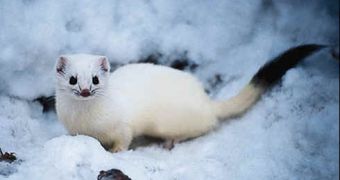The white fur of the stoats was highly prized during the Medieval Age, being used in the robes of many royal and noble figures. The furs were sewn together in a pattern of black dots made by the tail tips, the "in ermine".
These little devils are solitary and territorial. As small as they are, a female can have a territory of 1-110 hectares and a male up to 250 hectares (this depends on the food availability in the area). Usually, the territory of one male comprises the territories of several females (like in tigers or foxes). The male moves 0.6-1.4 km (0.4-0.9 mi) per night while the female 0.4-0.6 km (0.2-0.4 mi). The stoat runs through low jumps, with the back being arched.
In Ontario, 90% of the stoat's prey consists of meadow voles (Microtus penssylvanicus), while in Sierra Nevada (California) of mountain voles (Microtus montanus). This little carnivorous needs 70-170 g of meat daily. In fact, the effectives of the stoats fluctuate along with those of the voles and rabbits. Stoats can hunt underground, entering the tunnels of the moles or rats. Stoats also hunt water animals, like water voles, musk rats, ducks, moorhens, crayfish, frogs and fish, including salmons and trouts. Stoats and weasels are considered the most powerful predators given their size: killing a hare is like a lion killing an elephant by itself, as a stoat can be 125-300g heavy, and a hare 2.5-6 kg (5.5-13 pounds). Stoats kill their prey with a bite on the nape.
Stoats are famous for their winter coats. The change of the fur color is influenced by temperature, snowfall, freeze and altitude and takes place in just 79 hours! At 2' C, their flanks turn white; at -1' C, the whole body turns white, except for the black tip of the tail. In the lowland of France and England or southern US, where it rarely snows, they do not change color during winter. The fur turns completely white (black tail tip included) at latitudes over 50-55' N. In intermediary areas, the winter coat can be marbled.
Breeding takes place in March-July and stoats mate for 2-3 days. The copulation lasts 3 hours with pauses. This is possible because like in all carnivorous mammals (and not only), the male has a penis bone, which has 10-30 mg in the immature male, and reaches 50-90 mg in adult males, being 2-3 cm (0.8-1.2 in) long. The eggs are fecundated after a diapause of 9-10 months (that's why females give birth after about 337 days) (the same happens with long-tailed weasels). All animals in the weasel family give birth in nests made of dry leaves, moss and grass. Inside the abandoned dens of another animals, amongst stones or deep inside hollow trees.
In stoats, there are cases when males mated with their daughters inside the nests.
At 17 days old the offspring are blind, deaf and toothless. Teeth emerge at the age of 3 weeks and eyes open at the age of 4 weeks. By about 12-13 weeks of age females can breed. They can have up to 13 young. Males are sexually mature at the age of one year. Stoats can live up to 8 years, but in nature they rarely bypass one year.
During the winter, stoats upholster their nests with skins of the hunted rodents to conserve inner heat (any similarity with humans?).
Why do stoats have the Tails black-tipped? It is believed that this black tip attracts the attention of the predators that grab the tail, giving the stoats a chance to escape. And indeed, stoats have many predators: foxes, lynxes, cats, prey birds and owls. When attacked, the stoat emits the stenchy secretion of its anal glands, just like its relatives, the polecats and the skunks.
Stoats live in Europe, Asia and North America, to the south into North Africa and India.
The introduction of the stoat in New Zealand represented one of the highest ecological disasters. Stoats quickly eliminated many of the endemic flightless birds, like kakapo or owl parrot or the famous kiwi birds.
The first stoats-weasels appeared in Miocene (23-5 million years ago), when their genus Mustelus split from that of the martens (Martes). 4 million years ago, in Eurasia, Mustela plioerminea lived. 2 million years ago, there was Mustela palerminea. The modern stoat (Mustela erminea) appeared 500,000 years ago in Asia, from where it moved to Europe and North America. In Pliocene (5-2 million years ago), stout's cousin, the (least) weasel, Mustela nivalis, evolved in the mice rich grasslands appeared after the recession of the forests due to a drier clime. Both species inhabit cold and temperate northern areas, being limited in their advance southward by predation and competition.
The least weasel inhabits hedges and forest edges. It is active especially during the night, but it can go out also during the day in wet and muddy conditions. It hunts rats, mice, voles, moles, frogs, small birds and even fish, and attacks even larger animals. It can swim to chase preys like water voles, follow animals into their galleries and climbs into the trees looking for bird eggs and chicks. Unlike its relative, weasels can live in pairs. Mating takes place until June, and unlike the other species, which have one litter annually, weasels have two, with 2-7 offspring.
The North American long tailed weasel is appreciated as a rodent exterminator.
The Siberian weasel from central and northern Asia has a white winter coat very similar to stoat's.

 14 DAY TRIAL //
14 DAY TRIAL // 
